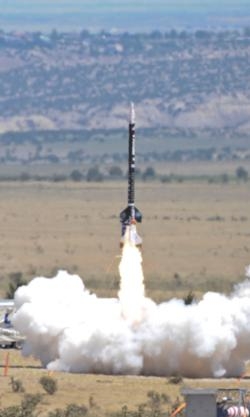Largest Rocket To Launch From Colorado Featured At Unique, Hands-On STEM Event
STEM education is a hot topic among technology companies and state and national leaders. It is a national priority to compete globally by advancing students' math and science learning and inspiring young people to pursue careers in STEM, which stands for science, technology, engineering and math. At one of the nation's most unique "hands on" STEM events, more than 100 students of all ages will launch their rockets and payloads high above the plains of Pueblo, CO, during the sixth annual Student Rocket Launch on Saturday, July 27.

"United Launch Alliance works with our customers over several years to deliver each mission to a precise location," said Matt Smith, ULA's vice president of Engineering and Information Technology. "The Student Rocket Launch allows our interns to simulate that experience, compressed into eight or 10 weeks, and offers young scientists the opportunity to design and build experiments of their own."
The launch event features three high-power rockets built by interns at United Launch Alliance (ULA) that will carry payloads (on-board science experiments) thousands of feet above the ground. The five largest payloads are built by Ball Aerospace & Technologies Corp. interns. K-12 students from Colorado and Alabama created 12 additional payloads. This year's rocket team includes approximately 60 interns from ULA and 48 interns from Ball Aerospace.
"Ball's internship program plays a critical role in recruiting and retaining talented, knowledgeable, and diverse employees," said Jeff Osterkamp, vice president, Engineering. "This rocket launch program allows our interns to gain start-to-finish program experience in just 10 weeks, while encouraging the innovation and teamwork that we value at Ball."
The event will take place at the Hudson Ranch, located just outside of Pueblo, CO.
"The Future" is the largest rocket launched in Colorado, standing 25-feet tall and weighing 320 pounds. It is designed to fly to approximately 9,000 feet above the ground, carrying 14 payloads. The "Stars 'N' Stripes" is a 17-foot rocket that will carry two payloads and "Atlas IV," at 10 feet tall, will deploy one payload.
The Future, Stars 'N' Stripes and Atlas IV are all built and refurbished by ULA summer interns in Centennial, CO; Decatur, AL; Harlingen, TX; Cape Canaveral Air Force Station, FL; and Vandenberg Air Force Base, CA. The interns volunteer to work on the rockets outside of their "day jobs," building and testing the rockets with the guidance of ULA employees who participate as mentors.
The Southern Colorado Rocketeers (SCORE), Colorado Springs-based rocketry club (COSROCs) and Northern Colorado Rocketry (NCR) also will be launching rockets throughout the event.
This year's rockets will carry a total of 17 payloads. The five largest payloads are built by Ball interns, collectively known as BIRST (Ball Intern Rocket Science Team), who design, build and test the payloads after work hours with the help of employee mentors.
This year's concepts include: a fully-equipped life support system carrying a crew of grasshoppers to a new home in Pueblo; a bio-friendly glitter bomb; a self-guided quad-copter; a wacky, wavy inflatable man; and a solar balloon with a surprise that should wow the audience, among many other sensors and cameras.
Twelve K-12 student teams from five schools in Colorado and Alabama also built payloads that will fly on the Future rocket. Many payloads incorporate parachutes, cameras and instruments including GPS, accelerometers and Geiger counters, and the student designers will use them to learn more about the environment, the atmosphere, descent velocities and even the best way to recharge AA batteries.
(Image provided by United Launch Alliance "The Future" launches in 2012)
 Classic Aero-TV: Pure Aerial Precision - The Snowbirds at AirVenture 2016
Classic Aero-TV: Pure Aerial Precision - The Snowbirds at AirVenture 2016 NTSB Final Report: Costruzioni Aeronautiche Tecna P2012 Traveller
NTSB Final Report: Costruzioni Aeronautiche Tecna P2012 Traveller ANN's Daily Aero-Linx (11.23.25)
ANN's Daily Aero-Linx (11.23.25) ANN's Daily Aero-Term (11.23.25): Request Full Route Clearance
ANN's Daily Aero-Term (11.23.25): Request Full Route Clearance Aero-News: Quote of the Day (11.23.25)
Aero-News: Quote of the Day (11.23.25)



